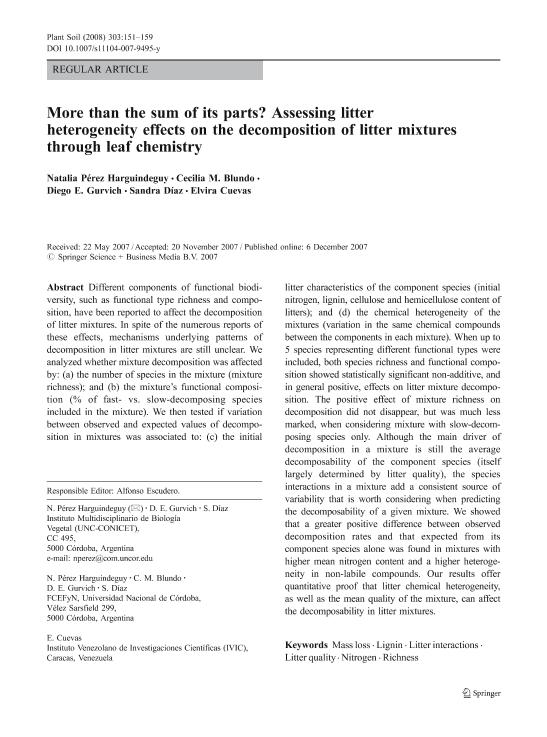Mostrar el registro sencillo del ítem
dc.contributor.author
Perez Harguindeguy, Natalia

dc.contributor.author
Blundo, Cecilia Mabel

dc.contributor.author
Gurvich, Diego Ezequiel

dc.contributor.author
Diaz, Sandra Myrna

dc.contributor.author
Cuevas, Elvira
dc.date.available
2017-07-31T18:16:13Z
dc.date.issued
2008-02
dc.identifier.citation
Perez Harguindeguy, Natalia; Blundo, Cecilia Mabel; Gurvich, Diego Ezequiel; Diaz, Sandra Myrna; Cuevas, Elvira; More than the sum of its parts? Assessing litter heterogeneity effects on the decomposition of litter mixtures through leaf chemistry; Springer; Plant and Soil; 303; 1-2; 2-2008; 151-159
dc.identifier.issn
0032-079X
dc.identifier.uri
http://hdl.handle.net/11336/21631
dc.description.abstract
Different components of functional biodiversity, such as functional type richness and composition, have been reported to affect the decomposition of litter mixtures. In spite of the numerous reports of these effects, mechanisms underlying patterns of decomposition in litter mixtures are still unclear. We analyzed whether mixture decomposition was affected by: (a) the number of species in the mixture (mixture richness); and (b) the mixture’s functional composition (% of fast- vs. slow-decomposing species included in the mixture). We then tested if variation between observed and expected values of decomposition in mixtures was associated to: (c) the initial litter characteristics of the component species (initial nitrogen, lignin, cellulose and hemicellulose content of litters); and (d) the chemical heterogeneity of the mixtures (variation in the same chemical compounds between the components in each mixture). When up to 5 species representing different functional types were included, both species richness and functional composition showed statistically significant non-additive, and in general positive, effects on litter mixture decomposition. The positive effect of mixture richness on decomposition did not disappear, but was much less marked, when considering mixture with slow-decomposing species only. Although the main driver of decomposition in a mixture is still the average decomposability of the component species (itself largely determined by litter quality), the species interactions in a mixture add a consistent source of variability that is worth considering when predicting the decomposability of a given mixture. We showed that a greater positive difference between observed decomposition rates and that expected from its component species alone was found in mixtures with higher mean nitrogen content and a higher heterogeneity in non-labile compounds. Our results offer quantitative proof that litter chemical heterogeneity, as well as the mean quality of the mixture, can affect the decomposability in litter mixtures.
dc.format
application/pdf
dc.language.iso
eng
dc.publisher
Springer

dc.rights
info:eu-repo/semantics/openAccess
dc.rights.uri
https://creativecommons.org/licenses/by-nc-sa/2.5/ar/
dc.subject
LIGNIN
dc.subject
LITTER INTERACTIONS
dc.subject
LITTER QUALITY
dc.subject
MASS LOSS
dc.subject
NITROGEN
dc.subject
RICHNESS
dc.subject.classification
Ecología

dc.subject.classification
Ciencias Biológicas

dc.subject.classification
CIENCIAS NATURALES Y EXACTAS

dc.title
More than the sum of its parts? Assessing litter heterogeneity effects on the decomposition of litter mixtures through leaf chemistry
dc.type
info:eu-repo/semantics/article
dc.type
info:ar-repo/semantics/artículo
dc.type
info:eu-repo/semantics/publishedVersion
dc.date.updated
2017-07-25T12:38:58Z
dc.identifier.eissn
1573-5036
dc.journal.volume
303
dc.journal.number
1-2
dc.journal.pagination
151-159
dc.journal.pais
Alemania

dc.journal.ciudad
Berlín
dc.description.fil
Fil: Perez Harguindeguy, Natalia. Consejo Nacional de Investigaciones Científicas y Técnicas. Centro Científico Tecnológico Conicet - Córdoba. Instituto Multidisciplinario de Biología Vegetal. Universidad Nacional de Córdoba. Facultad de Ciencias Exactas Físicas y Naturales. Instituto Multidisciplinario de Biología Vegetal; Argentina
dc.description.fil
Fil: Blundo, Cecilia Mabel. Universidad Nacional de Córdoba. Facultad de Ciencias Exactas, Físicas y Naturales; Argentina. Consejo Nacional de Investigaciones Científicas y Técnicas; Argentina
dc.description.fil
Fil: Gurvich, Diego Ezequiel. Consejo Nacional de Investigaciones Científicas y Técnicas. Centro Científico Tecnológico Conicet - Córdoba. Instituto Multidisciplinario de Biología Vegetal. Universidad Nacional de Córdoba. Facultad de Ciencias Exactas Físicas y Naturales. Instituto Multidisciplinario de Biología Vegetal; Argentina
dc.description.fil
Fil: Diaz, Sandra Myrna. Consejo Nacional de Investigaciones Científicas y Técnicas. Centro Científico Tecnológico Conicet - Córdoba. Instituto Multidisciplinario de Biología Vegetal. Universidad Nacional de Córdoba. Facultad de Ciencias Exactas Físicas y Naturales. Instituto Multidisciplinario de Biología Vegetal; Argentina
dc.description.fil
Fil: Cuevas, Elvira. Instituto Venezolano de Investigaciones Científicas; Venezuela
dc.journal.title
Plant and Soil

dc.relation.alternativeid
info:eu-repo/semantics/altIdentifier/url/https://link.springer.com/article/10.1007%2Fs11104-007-9495-y
dc.relation.alternativeid
info:eu-repo/semantics/altIdentifier/doi/http://dx.doi.org/10.1007/s11104-007-9495-y
Archivos asociados
